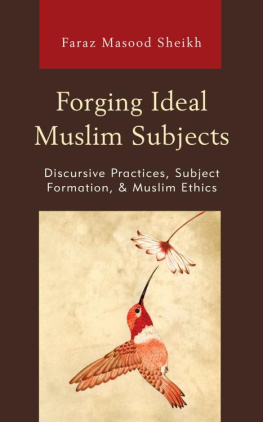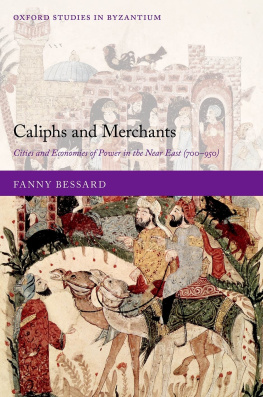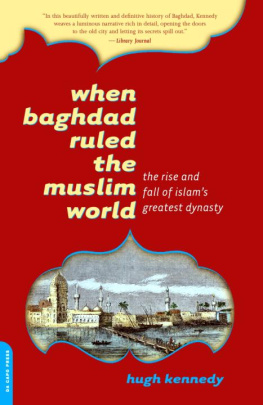First published in 1950
This edition first published in 2008 by
Routledge
2 Park Square, Milton Park, Abingdon, Oxon, OX14 4RN
Simultaneously published in the USA and Canada
by Routledge
270 Madison Ave, New York NY 10016
Routledge is an imprint of the Taylor & Francis Group, an informa business
Transferred to Digital Printing 2008
1950 A. S. Tritton
All rights reserved. No part of this book may be reprinted or reproduced or utilised in any form or by any electronic, mechanical, or other means, now known or hereafter invented, including photocopying and recording, or in any information storage or retrieval system, without permission in writing from the publishers.
British Library Cataloguing in Publication Data
A catalogue record for this book is available from the British Library
Library of Congress Cataloging in Publication Data
A catalog record for this book has been requested
ISBN 10: 0-415-42600-6 (Set)
ISBN 10: 0-415-44095-5 (Volume 30)
ISBN 13: 978-0-415-42600-8 (Set)
ISBN 13: 978-0-415-44095-0 (Volume 30)
eISBN: 978-1-134-53790-7
Publishers Note
The publisher has gone to great lengths to ensure the quality of this reprint but points out that some imperfections in the original copies may be apparent.
IAD Religio-Philosophy (Reprint) Series No. 41
PREFACE
In the middle of India it is hard to get books; I could find only one Jewish book and some only of the Christian authorities. This explains some of the deficiencies of my work. Much more than appears between inverted commas is translation, hence some variations in spelling and some unevenness in the English. My debt to von Kremer, Mez, Browne, Shedd, and Sir T. W. Arnold is obvious. appeared in the Journal of the Royal Asiatic Society; the former has been rewritten and the latter revised. I used Mr. H. I. Bells translation of the papyri. He suggests that the three taxes mentioned on p. 201 are land tax, poll-tax, and the tax for the support of officials. If some of the tales told by Muslims and repeated here are not true, it does not matter much. If invented, they must have been possible at the time of invention, or the inventor thought that they represented the true Muslim policy.
Dates are of the Hejira unless otherwise marked. The only contraction used is b, son of. Arabic history is full of proper names; only the more important are put in the index.
It is a pleasant duty to thank Prof. W. B. Stevenson, of Glasgow, Maulvi Abd ul Aziz Memon and Dr. S. Hadi Hasan, of Aligarh, for help given. The last named also undertook the wearisome task of reading the proofs.
A.S.T.
After the death of Muhammad, in A.D. 632 his community was ruled by three caliphs, who kept Medina, the City of the Prophet, as their capital. That was the time of the most spectacular conquests. The system of administration was simple. Arabs were appointed governors of the provinces and to a few of the chief posts in them, while most of the subordinate officials retained their posts. The great innovation was that the Arabs became the standing army and militia, and were paid by the state to protect it, the provincials supplying the money. Such organization of the state as there was, was the work of Umar I, who ruled from A.H. 13 to 23, A.D. 634 to 644.
From A.H. 40 to 132, A.D. 661 to 750, the Umayyad caliphs ruled. They moved the capital to Damascus, where the government was surrounded by a Christian population and exposed to the influence of an old civilization. Muawia, the first caliph, owed his success largely to having done his duty as an Arab and avenged the murder of Uthman, and in consonance with this he and his successors lived as Arab chiefs rather than as rulers of a great empire. They were Arabs first and Muslims second. The words attributed to Muawia, I found that the people of Egypt were of three sorts, one-third men, one-third like men, and one-third not men, i.e. Arabs, converted foreigners, and those who pretend to be Muslims, the Copts, reveals the Umayyad mind.The words, those who pretend to be Muslims, are probably an addition, but otherwise the saying may well be genuine. The chief distinction in that age was to be an Arab.
At first the idea was that no Muslim paid anything to the state, rather he was kept by it. In theory all revenue, except the profits of crown lands, came from non-Muslims. It is doubtful how far the religious taxes paid by Muslims were applied to their rightful object, the relief of the poor; they may have gone into the common purse of the state. As the provincials turned Muslim, and claimed exemption from tribute, the revenue diminished, and it was found necessary to compel the converts to pay. Umar II (A.H. 99-101, A.D. 717-720), who modelled himself on his namesake, tried to make a state in which all Muslims were equal, but died before he could accomplish much. Throughout the dynasty the antithesis was between Arab and non-Arab.
It was a popular saying at Damascus that under the caliph Walid men talked of fine buildings, under Sulaiman of cookery and women, and under Umar II of religion. The epigram illustrates the fact that the Umayyad caliphs took little interest in religion, and that Muslim law began its development away from the court and government.
The Umayyads fell as a result of internal strife and of an attack from without, which promised to elevate the family of the Prophet to the throne.
From A.H. 132 to 656, A.D. 750 to 1258, the Abbasids reigned, though they did not always rule. As they had been raised to power by Persians who were devoted to the family of the Prophet, the Abbasid caliphs were Muslims first and then monarchs in the style of the Great King. As Muslims they were exact in the performance of their religious duties, and often genuinely interested in religion. As most of their supporters were Persians, the Arabs lost their place of pride, and any Muslim, whatever his race, might hope for success at court.
As the antithesis between Arab and non-Arab disappeared, so that between Muslim and non-Muslim was sharpened. The salaries of the Arabs were stopped and all men paid taxes, though non-Muslims still paid their special poll-tax.
At the beginning of the dynasty the Abbasids ruled the whole Muslim world except Spain. In the reign of Mamun (A.H. 198-218, A.D. 813-833) we find hereditary governors of provinces, and about A.H. 250, A.D. 864, Egypt became practically independent under Ahmad b. Tulun. Then separate kingdoms arose in the east, while the caliphs entrusted their fortunes to Turkish mercenaries, who often tyrannized over their so-called masters.
In A.H. 334, A.D. 946, the Dailamite family of Buwaih, who belonged to the shia sect, conquered Baghdad, and the caliphs became puppets in the hands of schismatics.
In A.H. 358, A.D. 959, the Fatimid caliphs, who also belonged to the shia sect, conquered Egypt, and later Syria, and held them for two and a half centuries.
In A.H. 431, A.D. 1040, the Seljuk Turks founded a kingdom, and in A.H. 447, A.D. 1055, they took Baghdad. The caliph kept up the form of sovereignty with his vizier and ministers, but all power was in the hands of the Turks. When their might decayed, in A.H. 552, A.D. 1156, the Muslim world split into a number of small states, of which Baghdad, the seat of the caliph, was by no means the most important. Most of these were wiped out by the Mongols when they sacked Baghdad in A.H. 656.









